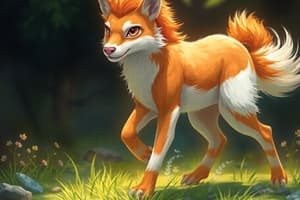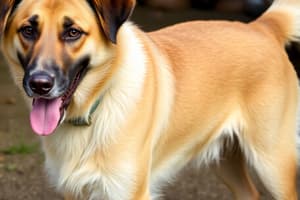Podcast
Questions and Answers
Дикие предки домашних животных. Изменения в процессе одомашнивания.
Дикие предки домашних животных. Изменения в процессе одомашнивания.
1
Понятие о породе, факторы породообразования. Структура породы.
Понятие о породе, факторы породообразования. Структура породы.
2
Классификация пород по направлению продуктивности, качеству и количеству труда, затраченного на их формирование.
Классификация пород по направлению продуктивности, качеству и количеству труда, затраченного на их формирование.
3
Методы учета и изучения роста и развития животных.
Методы учета и изучения роста и развития животных.
Основные промеры и индексы телосложения сельскохозяйственных животных.
Основные промеры и индексы телосложения сельскохозяйственных животных.
Расчетный метод определения живой массы сельскохозяйственных животных.
Расчетный метод определения живой массы сельскохозяйственных животных.
Основные закономерности роста и развития с.-х. животных.
Факторы, влияющие на рост и развитие с.-х. животных.
Основные закономерности роста и развития с.-х. животных. Факторы, влияющие на рост и развитие с.-х. животных.
Классификация типов конституции.
Классификация типов конституции.
Методы оценки животных по экстерьеру. Кондиции.
Методы оценки животных по экстерьеру. Кондиции.
Интерьер и его связь с продуктивностью с.-х, животных.
Интерьер и его связь с продуктивностью с.-х, животных.
Учет, оценка и отбор коров по молочной продуктивности.
Учет, оценка и отбор коров по молочной продуктивности.
Учет мясной продуктивности. Влияние различных факторов на мясную продуктивность.
Учет мясной продуктивности. Влияние различных факторов на мясную продуктивность.
Учет яичной продуктивности. Оценка и отбор птицы по яичной продуктивности.
Учет яичной продуктивности. Оценка и отбор птицы по яичной продуктивности.
Оценка и отбор животных по шерстной продуктивности
Оценка и отбор животных по шерстной продуктивности
Рабочая продуктивность лошадей.
Рабочая продуктивность лошадей.
Flashcards
Changes in the domestication process
Changes in the domestication process
The process of domesticating wild animals involves significant changes in their physical and behavioral characteristics. These changes occur over generations as humans selectively breed animals with desired traits.
What is a breed?
What is a breed?
A breed is a group of animals within a species that share distinctive characteristics passed down through generations. These characteristics are determined by genetics and carefully controlled by breeders.
Factors involved in breed formation
Factors involved in breed formation
Factors contributing to breed formation include selective breeding, environmental influences, and genetic mutations. Breeders carefully select individuals with desired traits to pass onto future generations.
Breed structure
Breed structure
Signup and view all the flashcards
Classification of breeds by productivity
Classification of breeds by productivity
Signup and view all the flashcards
Classifying breeds based on human effort
Classifying breeds based on human effort
Signup and view all the flashcards
Methods for studying growth and development
Methods for studying growth and development
Signup and view all the flashcards
Body measurements and indices
Body measurements and indices
Signup and view all the flashcards
Calculating live weight
Calculating live weight
Signup and view all the flashcards
Growth and development patterns
Growth and development patterns
Signup and view all the flashcards
Factors influencing growth and development
Factors influencing growth and development
Signup and view all the flashcards
Types of animal constitutions
Types of animal constitutions
Signup and view all the flashcards
Evaluating animals by exterior
Evaluating animals by exterior
Signup and view all the flashcards
The importance of animal interior
The importance of animal interior
Signup and view all the flashcards
Evaluating dairy cows by milk production
Evaluating dairy cows by milk production
Signup and view all the flashcards
Evaluating meat production
Evaluating meat production
Signup and view all the flashcards
Evaluating egg production
Evaluating egg production
Signup and view all the flashcards
Evaluating wool production
Evaluating wool production
Signup and view all the flashcards
Evaluating working horses
Evaluating working horses
Signup and view all the flashcards



